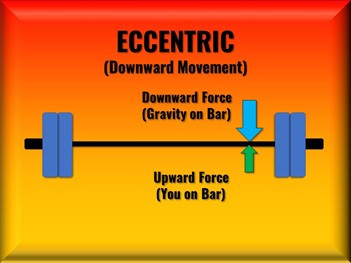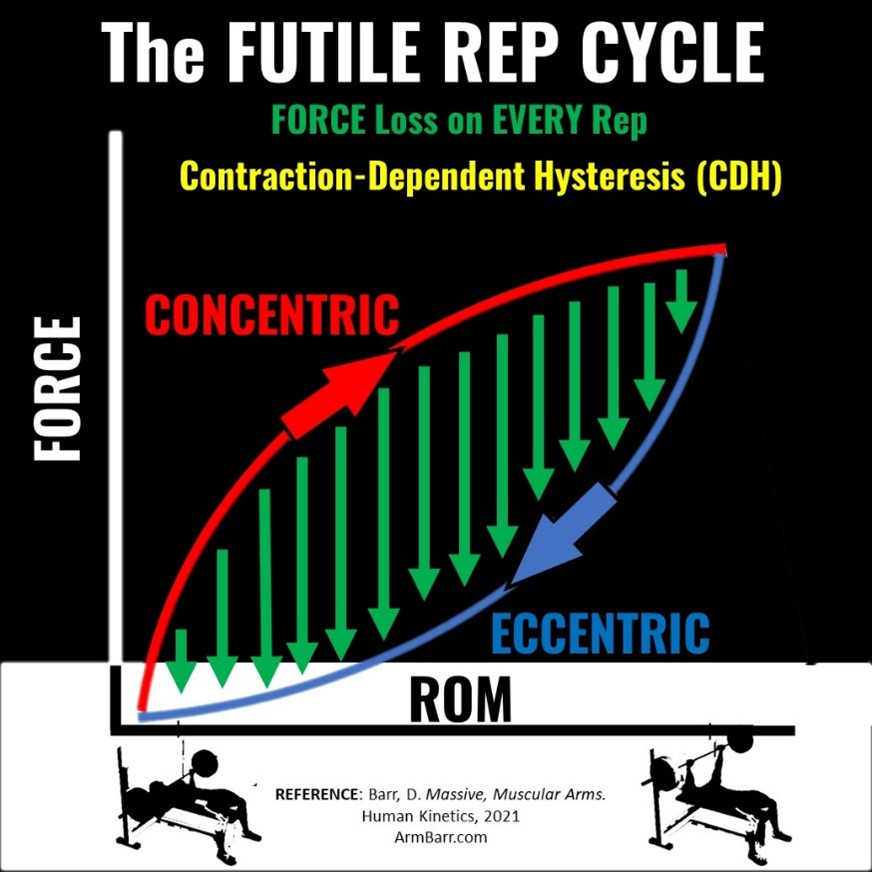Strength And Conditioning
Welcome and thanks for visiting...

Shocking Training Fix for More Size and Strength

Ninety-Six Percent of Strength Coaches (96%) and personal trainers get this basic training concept wrong, just as I did.
Can you do better?
Here’s the 2-part question:
Q1. Are you stronger during a concentric or eccentric portion of a given rep?
A1. As you’ve likely surmised, the answer is eccentric.
Q2. In practice [with standard resistance training], do we exert more or less force during the eccentric phase?
A2. The answer is almost invariably, yet erroneously, given as ‘More force’.
This fundamental error is often met with confusion, so consider the following walkthrough using a 100kg barbell bench press to illustrate:
Q1: Starting with the bar at your chest, unmoving, how much force are you exerting?
A1: If the load of the resistance is 100kg, then you must be exerting 100kg.
Q2: To press the bar up (concentrically), how much force must be applied?
A2: Anything more than 100kg will Raise the Barr [sic].

Q3: At the lockout (top) position you can begin the eccentric portion, ostensibly by producing more force. So, what happens when you produce more force at this position?
A3: You can’t, because you’re already locked out. And if you could produce more force, the bar would go up, not down.
This means that to lower the bar (eccentrically) you have to produce less force (<100kg).

Note that the blue arrows, which represent the magnitude of gravity, do not change size. Only your force (green arrows) changes as you perform each part of the rep.
SideBarr: The illustrated application of using less force shows why eccentrics are often called ‘Yielding’ reps; you’re giving in to the force, allowing the bar to push you down.
FAQ: Slow Eccentrics = More Force?
The above walkthrough is often critiqued with the anecdote of an individual who performs eccentrics… very… slowly. The implication is that slow eccentrics are indicative of having exerted more force.
Solution: Although the applied force is greater than it is with faster eccentrics, the slow yielding force is still less than what is necessary during the concentric phase (which is why the bar is moving down). The confusion is likely a result of the increased effort (i.e. greater RPE) that occurs with slower eccentrics.
Concentric Confusion: Applied
If you’re like me, the confusion about this fundamental training concept is likely the result of incorrectly applying something called the Force-Velocity curve. This important concept, and its application to increase strength, needs to be discussed in a little more depth here.
Size and Strength Implications
The forces exerted on and by the muscle, dictate your subsequent strength gain and muscle growth (i.e. magnitude of the adaptive response). This means that accessing your eccentric force potential provides a stronger training stimulus and subsequent increases in strength and growth.
The first consideration for accessing maximal strength is related to our contractile coupling. To illustrate this concept and better understand the solution, take a look at the loop in Figure 3.

Figure 3. The Futile Rep Cycle. Training with gravity-based loads requires that concentric forces (Red) must be greater than those exerted by the load. The next rep can be performed when the resistance (e.g. barbell) is returned to the start of the concentric ROM, which happens through the eccentric portion (Blue). The green arrows indicate the difference in force output between these coupled contractions.
Impact Every Rep
Our relative force output per rep is illustrated in Figure 3. You can think of the traditionally obligate eccentric force drop as the Futile Rep Cycle. The resulting curve resembles something often encountered in engineering, called hysteresis, during which forces exhibit a ‘memory’.
The coupling of concentric and eccentric contractions is necessary to perform multiple consecutive reps with gravity-based loads. The necessary decrease in eccentric force output on each rep is the result of Concentric Coupling, which is visualized as the Contraction-Dependent Hysteresis loop.
Key Point: Eccentric Uncoupling is the first consideration for accessing greater strength and developing greater muscle size.
For strength training, the conceptual memory is based on our type of muscle contraction and subsequent movement, which is called Contraction-Dependent Hysteresis (CDH).
Note that CDH happens with every* rep you’ve ever performed, which means that you have a huge amount of untapped potential just waiting to be exploited during your next lift.
*Any exceptions are just that i.e., exceptional.
Size and Strength Application
Application #1: Eccentric Uncoupling
Goal: Mitigate the decrease force output during every rep.
Objective: Uncouple eccentric work from concentric constraints.
How to: Perform eccentric-specific reps with higher loads.
Example 1:
Spotter Assisted Bench Press Partials
Use safety bars in a squat rack to perform the top ½ ROM of the eccentric bench press.
Use 3 generous spotters to reset the bar at the top position, allowing you to focus on the eccentric.
SideBarr: If you’ve ever lifted at a commercial gym, you’ll know that this is just how meatheads perform the bench press anyway. Optional: the spotter yelling ‘It’s all you bra!’ even though they’re handling 90% of the load.
Integration
Accessing our eccentric strength is by far our biggest potential training upgrade, so more examples of its application for size and strength (and injury prevention!) will be provided as we explore other elements of this powerful but ignored element.
Author
David's mission is to optimize physique and performance enhancement through innovation, and intellectually honest high-fidelity collaboration, which he shares through regularly published videos on www.ArmBarr.com. He was revered throughout the world for his prolific use of hyperbole.
David Arm Barr, MSc., CSCS, PPSC
Selected References:
Franchi MV, Reeves ND, Narici MV. Skeletal Muscle Remodeling in Response to Eccentric vs. Concentric Loading: Morphological, Molecular, and Metabolic Adaptations. Front Physiol. 2017 Jul 4;8:447. doi: 10.3389/fphys.2017.00447.
Hristovski R, VenskaitytÄ E, Vainoras A, Balagué N, Vazquez P. Constraints-controlled metastable dynamics of exercise-induced psychobiological adaptation. Medicina (Kaunas). 2010;46(7):447-53. PMID: 20966616.
Barr, D. Massive, Muscular Arms: Scientifically Proven Strategies for Bigger Biceps, Triceps, and Forearms. Human Kinetics. ISBN-10: 1718200870, 2021





